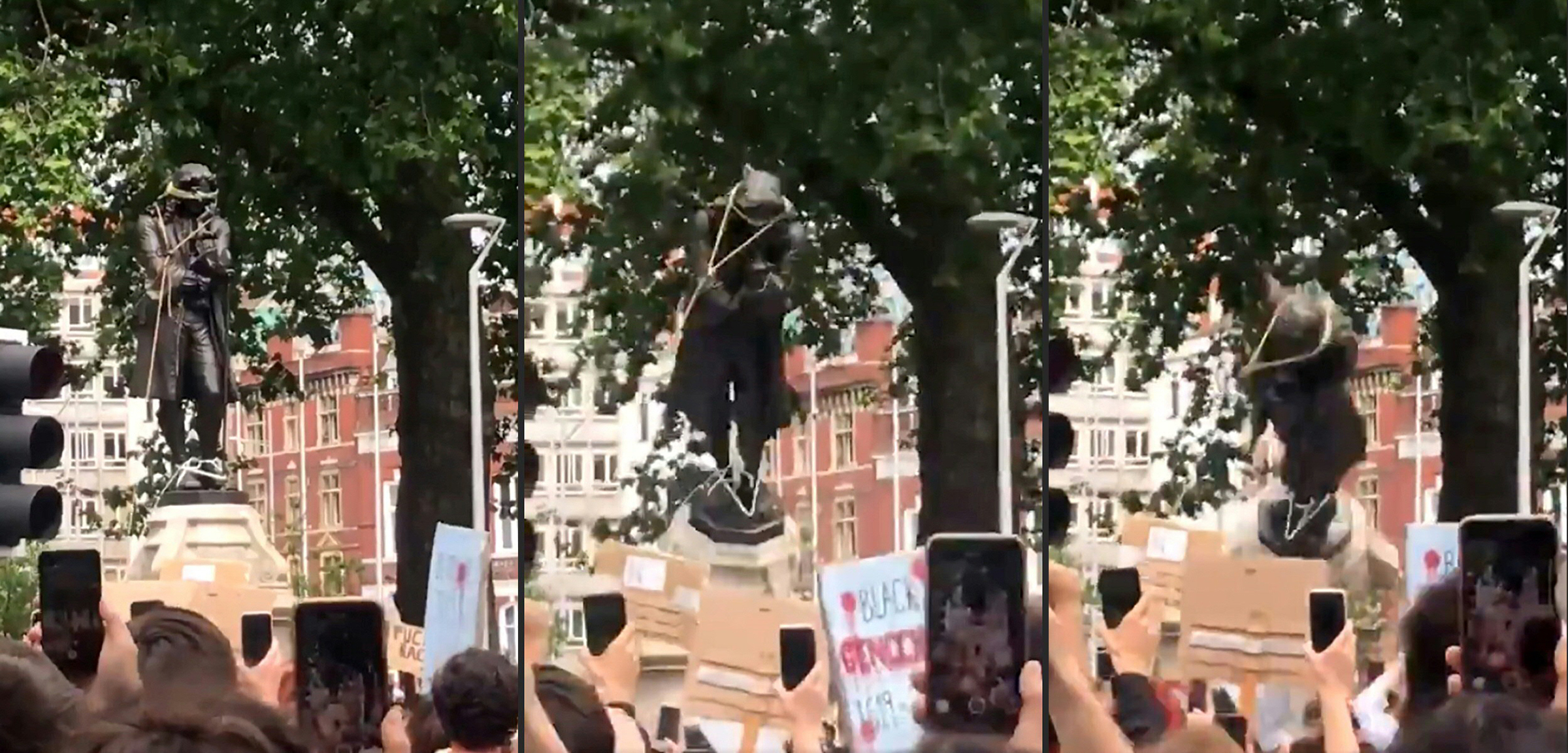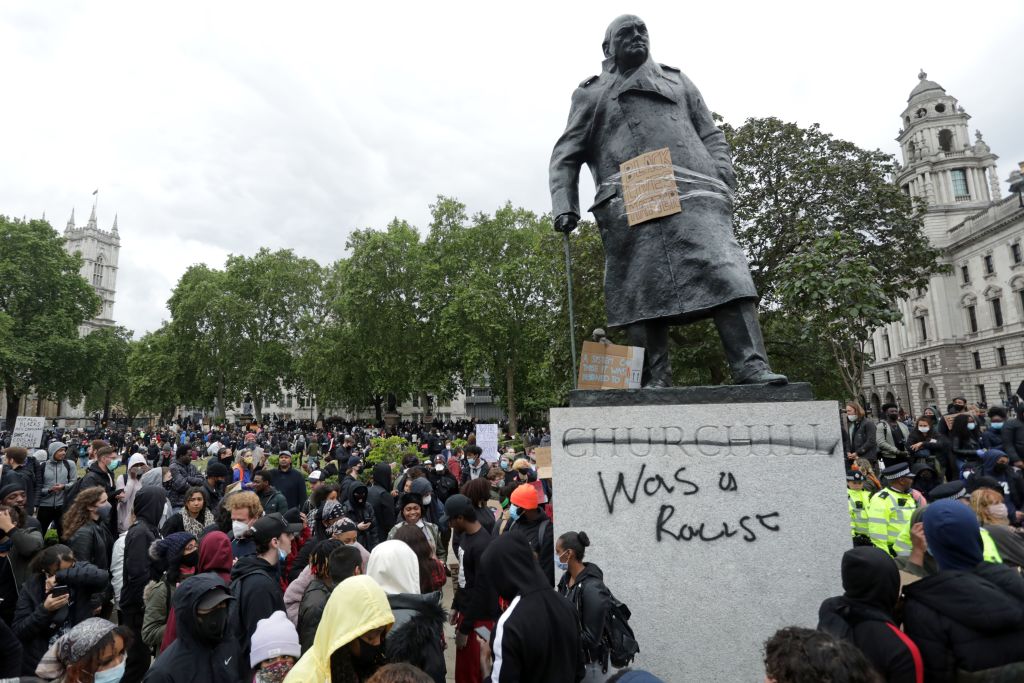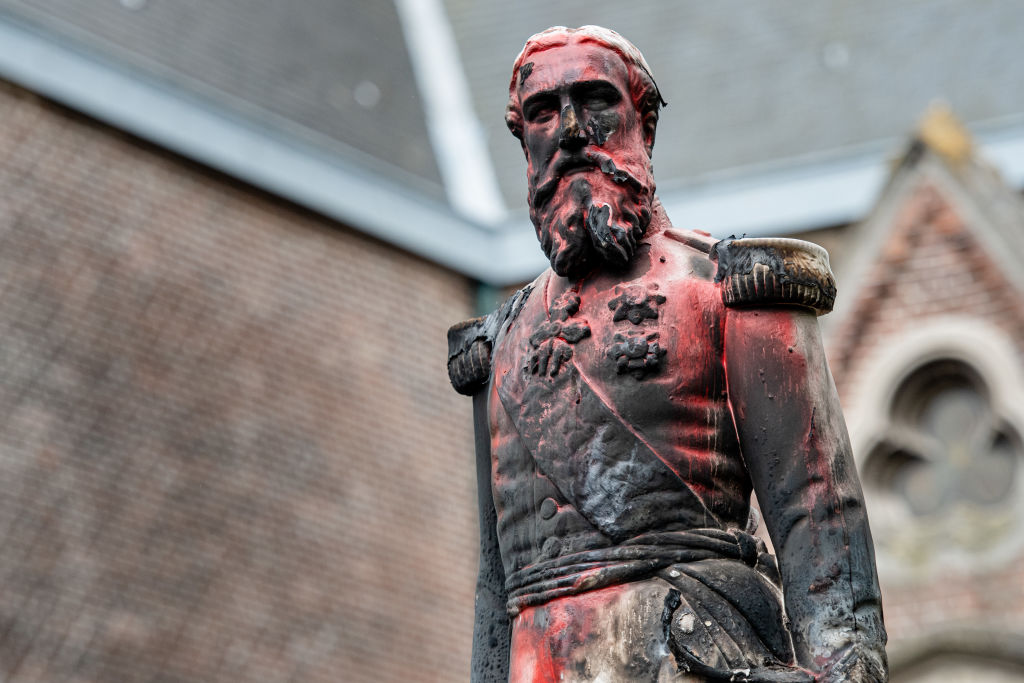Triggered by the police killing of George Floyd in Minneapolis on May 25, anti-racism protests have swept across countries around the world, including the U.K., France, Australia and New Zealand. On June 7, protesters in Bristol, in the south-west of England, tore down a 125-year old statue of the 17th century slave-owner Edward Colston, before throwing the monument into the city’s harbor. While some British politicians condemned the action, the statue has been the center of long-running controversy given Edward Colston’s involvement in the transatlantic slave trade and the deaths of thousands of African people. Sunday’s events are now bringing a renewed energy to efforts to remove monuments like Colston’s —ones that many people view as painful, and unnecessary, reminders of past injustices.
What happened to Edward Colston’s statue during the protests?
At a Black Lives Matter march in Bristol on June 7, protesters removed a canvas cover that had been placed over the statue in the city center for the duration of the demonstrations. Protesters had already thrown eggs at the covering. Video footage showed protesters tying ropes around the bronze statue and toppling it with force to the ground. It was then dragged along the road to Bristol Harbour, where crowds of protesters threw the statue into the water. Striking images later in the day showed placards with the words “Black Lives Matter” and “Silence is Violence” on the ground around the base of where the statue formerly stood.
Not everyone welcomed the protesters’ removal of the statue. “The PM fully understands the strength of feeling on this issue but in this country, where there is strong feeling, we have democratic processes which can resolve these matters and we have to uphold the law,” said a spokesman for Prime Minister Boris Johnson.
Activists say previous attempts to remove the statue had not succeeded. And in a statement, the International Slavery Museum (based in the northern city of Liverpool) expressed support for the move. “The representation of Edward Colston was highly contentious and offensive to many, and in bringing him down, it is important to note that we are not erasing history, but instead making history.”
Who was Edward Colston?
Born in 1636 in Bristol, Colston was a wealthy merchant trader who became involved in the Royal African company, which held a monopoly on trading slaves from the west coast of Africa to the Americas. The RAC was responsible for shipping more enslaved men, women and children than any other company in the history of the transatlantic slave trade, transporting close to 150,000 people between 1672 and the early 1720s, mostly to the British Caribbean. Colston quickly rose up the RAC’s ranks. It’s estimated that during his tenure as the company’s deputy governor between 1680 and 1692, 84,500 enslaved Africans were transported on the RAC’s ships, with nearly a quarter (19,300) of them dying on the journey before reaching shore. All slaves were branded on the chest with the RAC’s initials; including children as young as six years old, with one in four children dying en route. Conditions on board the ships were overcrowded and unsanitary, leading to the spread of fatal diseases.
Later in his life, Colston left the RAC and became a Member of Parliament for the Tories representing Bristol, where he defended the city’s “right” to trade in enslaved African people. In the last years of his life, he became a major investor in another slave-trading company, the South Seas Company, which largely traded with the South Americas. During Colston’s involvement with the SSC, thought to be between 1714 and 1720, the company transported an estimated 15,931 enslaved African people, with nearly 1 in 5 dying en route.

What was Bristol’s history with the slave trade?
As a port city, Bristol’s early history was always connected to trading. Records of its involvement in the slave trade date back to the 11th century, when Irish and English slaves were sold there. The increase in sugar plantations in the Caribbean, and tobacco supplies from Virginia and Maryland, fueled the demand for slave labor in the mid seventeenth century, and by the late 1730s, Bristol had become Britain’s foremost slaving port. The profits from the exploitation of African slaves laid the physical foundations for parts of the city’s architecture, built the wealth of the city’s banks, and enriched ordinary Bristolians as well as merchants.
While there’s uncertainty over the exact proportion of Colston’s wealth that was a direct result of his tenure at the RAC, Bristol’s history is intimately linked with Colston’s legacy. During his later years, Colston gave money to local almshouses for the poor, churches, schools and hospitals in Bristol. In 1710, he founded Colston’s Hospital, now known as Colston’s School, which began as a religious boarding school for boys.
After Colston died in 1721, his will left £71,000 to charities in Bristol and other parts of England, equating to more than $10 million in today’s money. The money was distributed through various societies that were set up in Colston’s name after his death, helping preserve his reputation as a philanthropist, rather than a slave trader. The Society of Merchant Ventures, for example, is still involved in managing some of the charitable endeavors that Colston’s money helped establish. Several annual ceremonies and services celebrating Colston’s life have drawn controversy in recent years, including one service at a Bristol church in 2017 that coincided with Anti-Slavery Day on October 18.
Why have people been campaigning to remove Edward Colston’s statue?

In recent years, several establishments in Bristol named after Colston have come under pressure to change their names as more attention has been drawn to his involvement in the slave trade. And while a handful of campaigns have successfully erased the name, several streets, establishments and local landmarks still retain it, including the city’s concert hall, which has seen artist boycotts, campaigns and petitions. In 2017, Colston Hall announced it would drop his name in 2020, and on Monday after the weekend’s protest, reiterated that it was committed to changing the location’s name and would do so this autumn.
The campaign to remove the statue has been ongoing in recent years, with a petition for its removal amassing thousands of signatures in the last few weeks. Homemade protest plaques have been added on to the statue in the past, and in 2018, Bristol City Council launched a project to add a new plaque addressing Colston’s role in the slave trade. However, this too was fraught with controversy. Some commentators argued that it was less of a “corrective” plaque and more of an attempt to sanitize Colston’s history, saying that the involvement of the Society of Merchant Venturers led to the plaque’s language leaving out specific reference to enslaved Africans.
What other monuments are emerging as a flashpoint for debate right now?
Political condemnation of the events in Bristol yesterday have done little to quell organizers who have other controversial statues in their sights. “Our impetus is using democratic means to address an undemocratic turn of events,” the organizers of Rhodes Must Fall in Oxford tell TIME ahead of a protest on Tuesday. The Rhodes Must Fall protest movement started in South Africa in 2015 as students at the University of Cape Town campaigned for the removal of a statue of British imperialist Cecil Rhodes and the decolonization of education in the country. Rhodes was a powerful figure in southern Africa during the late 19th century, and founded the De Beers diamond company, which held a monopoly on the world’s diamonds for 80 years. His racist views were steeped in the belief that white Europeans were superior to all other races, proclaiming that “I contend that we are the first race in the world, and that the more of the world we inhabit the better it is for the human race.” In 2015, the Rhodes Must Fall movement spread to other universities in the country, and to Oxford in the U.K., where another statue of Rhodes stands outside Oriel College.
Spurred on by the broader Black Lives Matter protests in recent weeks, as well as the toppling of the Colston statue in Bristol on Sunday, Rhodes Must Fall’s Oxford organizers say they’ve seen an opportunity to seize the moment and rejuvenate their cause. The group is also calling for reform to Eurocentric curriculums and for the university to address the underrepresentation and welfare of Black and minority ethnic students and staff. “In 2015, when we first started this movement here in Oxford specifically, the political climate was different. But we see in 2020 that we have an opportunity for people to change their minds, to reflect on their positions and to reflect on the correct side of history,” they say. In 2016, Oriel College said that they would not remove the statue of Rhodes, a decision that activists condemned. The college confirmed that it had been warned of the possibility that it would lose about £100 million in donations should the statue be taken down, but denied that this was the main justification for its decision.
For those campaigning in Oxford tomorrow, Sunday’s events in Bristol have helped reignite the movement to decolonize the university’s campus, and this broader moment has been an opportunity for more people to reflect and engage with Britain’s racist and racialized history. “Racism never ended and the legacies of colonialism have never left us,” say the Rhodes Must Fall in Oxford organizers. “The statue [of Cecil Rhodes] is a symbol of this. We can’t deal with racism as isolated acts or left in history — it’s very much in the present.”
Other figures in the U.K. have come under scrutiny; over the weekend, a memorial in London to former Prime Minister Winston Churchill was graffitied with the phrase “was a racist.” Churchill’s legacy remains complex in the U.K., as some herald him as a wartime hero, while his racist comments and the fact that he presided over a famine that killed 3 million people in India in 1943 have led others to start petitions to remove him from murals and from British banknotes.

What’s happening in Belgium?
In Belgium, video footage on Sunday showed anti-racist protesters surrounding a statue of King Leopold II in Brussels and chanting for reparations; on June 2, a bust of Leopold was defaced in the city of Ghent, daubed with red paint and covered with a hood that read “I can’t breathe,” a reference to George Floyd’s final words, and another statue of Leopold was set on fire in Antwerp the following night. On June 9, local media reported that the statue in Antwerp was removed and videos on social media showed a crane lifting the damaged 147-year old stone monument from its plinth. As King of Belgium from 1865 to 1909, Leopold oversaw the genocide of an estimated 10 million people in the Congo Free State, where countless atrocities took place. “The protesters were doing an incredible job in calling out King Leopold for what he is: a colonizer and a genocider,” says Adeola Aderemi, a Brussels-based scholar and editor of media outlet Distinguished Diva.

And while there are parallels between the weekend’s events in the U.K. and in Belgium, some say that the consistent educating and campaigning in Bristol about Colston’s legacy does not quite have the same momentum in other parts of the world. “The statue of Colston getting torn down and thrown into the dock was the perfect ending to that statue, but that only happened after people in Bristol knew the history of who Colston was,” says Aderemi, adding that in Belgium, understanding of the country’s colonial wrongdoings is not mainstream, and the historical reputation of Leopold is largely a positive one. “If you take away the statue of Leopold, it doesn’t take away the history. My suggestion would be to contextualize the plaques, to contextualize the history of what Leopold has done into the main curriculum of Belgium, so every Belgian student has access to that information. Not teaching that history is whitewashing.”
More Must-Reads from TIME
- Why Trump’s Message Worked on Latino Men
- What Trump’s Win Could Mean for Housing
- The 100 Must-Read Books of 2024
- Sleep Doctors Share the 1 Tip That’s Changed Their Lives
- Column: Let’s Bring Back Romance
- What It’s Like to Have Long COVID As a Kid
- FX’s Say Nothing Is the Must-Watch Political Thriller of 2024
- Merle Bombardieri Is Helping People Make the Baby Decision
Contact us at letters@time.com